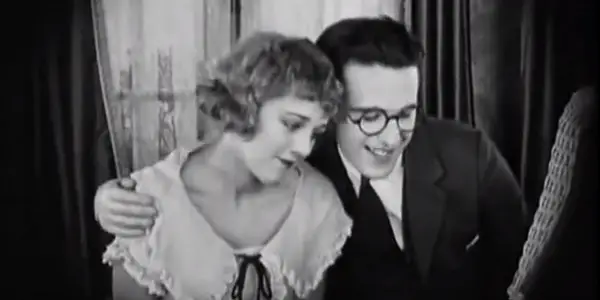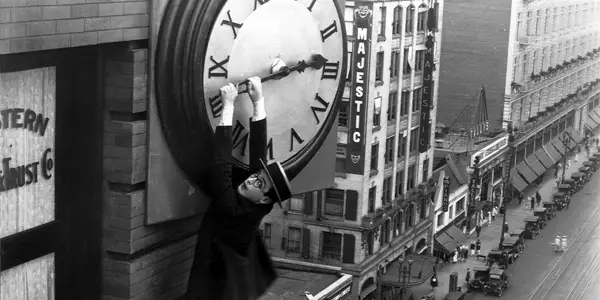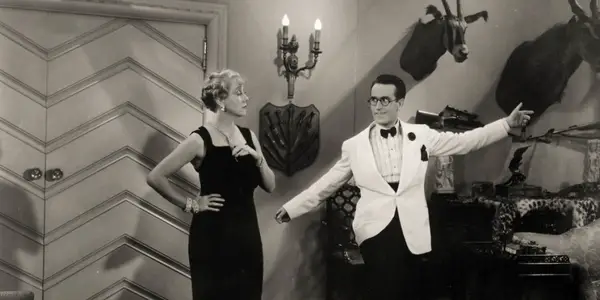Actor Profile: Harold Lloyd

Amanda Mazzillo is a writer with an MFA in Dramatic…
Whenever I see people pose the question Keaton or Chaplin, I wonder but what about Harold Lloyd? All of these performers must be remembered and appreciated when discussing silent film and the history of comedy. Harold Lloyd had a long, memorable, and successful career, yet his work still seems overlooked. He he was commonly not credited when he wrote or directed his own work, giving the impression that he did not have a say outside of acting. His plethora of physical comedy talents make his multitude of performances memorable.
Early Career in Short Films
Throughout many of his early short films, Lloyd developed characters which came back in his feature films. One of Lloyd’s shorts, Haunted Spooks (1920), follows a young woman, Mildred, played by Mildred Davis, who is left with a house and plantation in a will, but the specifics of the will involve her living in the house for a year with her husband, though she isn’t married.
The film is more well-known, though, for its scenes of Harold Lloyd’s character, also named Harold, before he meets Mildred. Lloyd portrays a young man, who is vying for the chance to ask his dream girl to get married, but she has two other suitors, leaving Harold and another man alone. This heartbreak leads to the scene for which the film is the most known: a series of depictions of Harold trying to kill himself and failing. This segment is an early use of darker themes with a comedic tone, something which frequently comes up in Lloyd’s comedy, especially with his preference for stunt-based physical comedy.
Walt Disney saw Haunted Spooks, and liked this segment so much, he asked Floyd Gottfredson to create a series of comics chronicling Mickey Mouse trying and failing to commit suicide after he sees Minnie with someone else.
This short was also influential in its plot surrounding Mildred’s will. Mildred’s uncle sets up traps throughout the house, trying to make it seem haunted so Mildred and her husband would move out. This inspired many future haunted house films as well as a staple in the Scooby-Doo, Where Are You! library. The use of an older character trying to ruin the lives of young people by faking the supernatural is something used in many episodes of this classic cartoon. Lloyd and Davis married in 1923, after being on-screen partners for many years. This chemistry comes through in the films they made together.

Another of Lloyd’s short films I would like to focus on is I Do (1921). This film also stars Harold Lloyd and Mildred Davis as a couple. The film starts with the characters getting married and goes forward to the two pushing a baby carriage, yet this short is set during the Prohibition, and the carriage instead houses a bottle of alcohol.
The film progresses once Harold is back to the home he shares with Mildred to see his brother-in-law standing outside with his two children and a basket of their belongings, leaving the children under Harold’s care. This film is physical in nature, but not to the same extent of Lloyd’s feature length work, as the film takes place mostly inside a house.
I Do includes elements of physical comedy, but has much more of a focus on the comedic moments surrounding raising children. This film is still relatable in modern society. Even if we do not take care of our children in exactly the same way, a modern audience can relate to trying to keep children happy, while keeping your house relatively clean. Harold is unprepared for child-care, given the children with no warning, and the film shows the comedy surrounding someone unsuccessfully trying to keep track of two children.
In the end, Mildred announces that she is pregnant, and you can see the apprehension and dread of raising children mixed with the love they have for one another and their desire to build a life together.
After having a successful career in short films, Lloyd went on to star in a series of feature length films. He is more well-known for the silent films displaying his comedic and artistic talents, but his career did not end there. He transitioned into sound films, before looking back across his career and editing together some of his best work into comedic specials. These specials helped a whole other generation to appreciate and enjoy his work. By keeping copies of all his work and making sure they were kept in good condition, Lloyd was able to make sure his films will never be forgotten or lost.
Success in Feature Films
In 1923, Lloyd made one of his most influential and well-remembered films, Safety Last!. This film is a perfect representation of Lloyd’s combination of stunt comedy, romance, and societal commentary.
The film follows a young man (Harold Lloyd) who takes a job in the city to earn money for him and his girlfriend (Mildred Davis). Harold manages to get a job as a salesclerk, but wants Mildred to think he is more successful, so he sends her expensive gifts he cannot afford. By doing so, Mildred thinks Harold is successful enough to marry her and start their family, so she takes a train to join him in the city. Once Mildred is in the city, Harold begins to lie about being the manager instead of a salesclerk.
Having Lloyd’s character unable to find a high paying job, yet lying to his loved ones about his position shows the tension between different social and economic classes present in the early 1920s, and still present today. In order for Harold to earn enough money to marry Mildred, he must put himself in a dangerous situation. The true manager of the store offers $1,000 to anyone who can draw business to his store. After seeing his roommate Bill scale a building, Harold offers to pay him $500 to scale the building which houses the store. When the film comes, Bill can no longer do the stunt, so Harold must perform it himself.
Safety Last! goes to show how much Harold Lloyd has influenced cinema. The film included one of Lloyd’s most memorable scenes, where his character is hanging from a clock tower, a scene which influences Back to the Future, as well as including a miniature clock of the scene in Safety Last! near the beginning of the film.

Safety Last! has also remained an influence in the romantic comedy genre, with its focus on relationship struggles, such as not feeling good enough or well-off enough to commit to each other. Safety Last! did a wonderful job of combining the comedy of daily work life and romance with the stunt-based comedy for which Lloyd is well-known.
In 1924, Harold Lloyd starred in Girl Shy, a film following a young man so shy, he can barely speak when he is around girls. Despite this, he wrote a “How to” book on lovemaking, something he had never personally experienced. The film utilizes fantasy sequences showing different chapters from his book, each detailing how to woo a certain type of woman. These scenes are amusing in the way they utilize different aspects of Lloyd’s comedic talents without pulling us too far away from the awkward personality of his character.
While taking the train in order to meet up with a publisher, Harold meets a rich young woman, Mary Buckinham, played by Jobyna Ralston. She sees his manuscript, which leads to the two talking and his stutter almost falling away completely. The two do not even realize the train has come to its final destination, and they are all alone, still happily talking and getting to know each other.
Like Safety Last!, this film also deals with Lloyd’s character wanting to earn money in order to feel he can ask the woman he loves to marry him. This focus on social class differences permeated throughout Lloyd’s work. Even in For Heaven’s Sake (1926), his least favorite film, Lloyd was able to make comments on the struggles and differences between social class, though this time he was playing the wealthy character, instead of the relatable boy-next-door type he favored before and after. Lloyd made sure this was the last time he played a wealthy character, preferring to play characters to which the audience relates and wants to see succeed.
For Heaven’s Sake shows two vastly different aspects of the same city and its inhabitants. Harold Lloyd plays Harold Manners, a wealthy man shown destroying an expensive car, and purchasing another without a single thought. On the other side of town, we meet Hope (Jobyna Ralston), the daughter of a minister who is planning to open a mission once he raises enough money.
In an early scene, we see the simple action of drinking a cup of coffee in these two different worlds. The film shows the world Harold Manners lives in, where coffee is served on a silver rolling cart, and from a perfectly clean cup. The shot of the cup being placed back on its silver resting place transitions to a similar yet completely different scene, where a chipped cup filled with coffee is sitting on a cart in the street, where less fortunate citizens can come for a free cup of coffee.
I thought this transition between shots helped to push the film’s focus on societal differences, and introduce the main characters, especially Hope and her father, who run the coffee cart as part of the mission they greatly wish to extend to a building, offering the members of their community a place to meet and take a break from the streets.
For being Lloyd’s least favorite film, For Heaven’s Sake still manages to be a wonderful mixture of societal commentary and physical comedy for which he is known. One of the more memorable scenes in the film is near its end. In order to reunite with Hope after being kidnapped by his old friends, Harold must bring his drunk groomsmen through the city, with his wedding being the final destination. This scene combines the humor typically found surrounding drunk characters, but with the addition of stunt-based comedy, such as the characters teetering all over a double decker bus, hoping not to fall off.
Transition from Silent to Talkies
Harold Lloyd’s early transition into sound features were all very similar to his earlier work in silent films. Welcome Danger (1929), his first sound feature, was a huge success with audiences, many of which were looking forward to hearing his real voice on film.
Feet First (1930) followed a very similar plot and structure to his earlier film Safety Last!. This film also followed issues of class differences. Lloyd plays Harold Horne, a shoe salesman who meets Barbara (Barbara Kent), his boss’s secretary. Thinking she is the boss’s daughter, he lies about his position, telling her he is a millionaire leather tycoon.
Many of Lloyd’s comedies involve characters hiding lies, especially those surrounding economic class. In Feet First, the comedy develops from Harold trying to hide his lie. In a memorable aspect of the film, Lloyd’s character ends up trapped inside a mailbag, and when he escapes, he is dangling above the streets, leading into his scaling of a building, much like in Safety Last!.
The Milky Way (1936) was Lloyd’s first large departure from the genre he made his own through his shorts and features. This film was a more traditional screwball comedy, a genre very far removed from Lloyd’s physical-based comedy. Screwball relies heavily on dialogue and the speed of delivery. Lloyd made the genre his own, by mixing the traditional elements of the screwball with physical elements more commonly found in silent films, as well as with simple vocal effects, which were used within silent films.
One scene that stands out in The Milky Way is near the beginning of the film, and involves Lloyd’s character Burleigh Sullivan trying to stop hiccuping. This was such a small moment, yet it introduced the character in a way which made him relatable.
The film follows Burleigh, a milkman at Sunflower Dairies, who ends up becoming a prizefighter through fixed fights. Burleigh comes across two drunk men trying to chat up his sister, Mae (Helen Mack). One of these men was the middleweight champion Speed McFarland (William Gargan), who ends up knocked out simply by Burleigh ducking to get out of the way of a punch.

McFarland’s boss, Gabby Sloan (Adolphe Menjou) plans a serious of fixed fights with Burleigh, leading to him getting knocked out in the championship. In the delightful screwball fashion, Burleigh ends up winning this fight, becoming the world champion.
Throughout the film, Lloyd combines the talents frequently seen in his silent films along with new talents uniquely prominent to the screwball genre. The fixed fights through the film work as a nice way to infuse Lloyd’s strength for physical comedy within the unfamiliar genre.
Samuel Goldwyn bought the rights to the property in order to make his remake, The Kid from Brooklyn. He also bought the original negative and almost all existing prints of the films, and destroyed them. Lloyd, known for preserving his own original nitrate prints of his films, is the only reason this film is currently available.
The Milky Way has inspired both the direct remake as well as inspiring the 2004 mockumentary film The Calcium Kid, which also follows a mild-mannered milkman who becomes a boxer.
After the 1938 film Professor Beware, Lloyd did not act until 1947’s The Sin of Harold Diddlebock, where he reprises his role from the film The Freshman. This was Preston Sturges’ first film after leaving Paramount Pictures and forming California Pictures with Howard Hughes. Hughes managed to get Lloyd to come out of retirement to make this film, but as the production went on Lloyd and Hughes had a falling out over creative differences.
The Sin of Harold Diddlebock followed Lloyd’s optimistic character from The Freshman into the Great Depression. By some, the film is regarded to be a comedic masterpiece, but more commonly the focus is on the problems during production. Lloyd never acted in another film after his experience on The Sin of Harold Diddlebock. Instead, he took to editing his previous work into compilations, which are still being seen today, and introducing people to Harold Lloyd’s World of Comedy.
After only playing in three cities, Hughes pulled the film from distribution, because of its poor performance. The film was not released again until 1950, where it was re-titled Mad Wednesday and cut from 89 to 76 minutes. Sturges felt Hughes cut out all the best parts of the film, making the edited version less comically interesting and character driven.
Harold Lloyd: Conclusion
Harold Lloyd’s career has spawned many decades through comedy shorts, feature films, and edited specials of his previous work. His work has greatly inspired comedians and film-makers for years to come. Even if he is not as widely talked about as Chaplin or Keaton, Lloyd’s work is still an important part of the history of silent comedy.
Who is your favorite silent film comedian? Which Harold Lloyd films do you think best capture his talents as a comedian and stunt performer?
Does content like this matter to you?
Become a Member and support film journalism. Unlock access to all of Film Inquiry`s great articles. Join a community of like-minded readers who are passionate about cinema - get access to our private members Network, give back to independent filmmakers, and more.
Amanda Mazzillo is a writer with an MFA in Dramatic Writing from SCAD and a BA in Writing & Linguistics and Film Studies minor from Georgia Southern University. She enjoys writing comedy and exploring all forms of media. Her Twitter name is a bad pun: @mazzillofirefox













